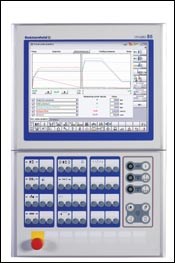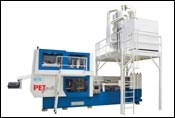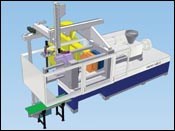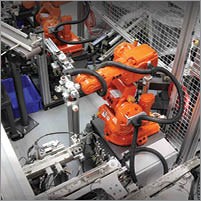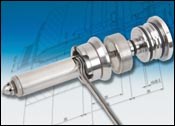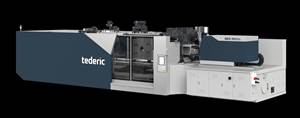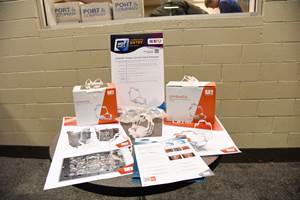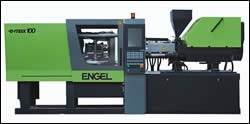What's New at the Show in INJECTION MOLDING
At the big “K” Show next month, top billing goes to new all-electric machines aimed at every segment of the market, from general-purpose to high-end.
At the big “K” Show next month, top billing goes to new all-electric machines aimed at every segment of the market, from general-purpose to high-end. Suppliers will introduce new lines and fill out their existing ranges with smaller or larger sizes. Hybrids, too, will make news with designs ranging from essentially hydraulic machines having an electric screw drive to mostly electric machines that retain hydraulics for high-pressure clamping or high-speed injection.
There will also be room in the spotlight for new and improved hydraulic models that tackle everything from large parts to high-speed packaging. Look for two-platen machines in smaller sizes, new controls that add more functions and/or are easier to use, and PET preform machines for lower volume production. Preform molders also won’t want to miss the demonstration of new competition from high-speed compression molding.
Several new types of machines will be unveiled, including presses for high-speed production of caps and closures and systems that combine multiple processes, such as injection and compounding to produce novel materials; extrusion and injection for making sophisticated long, thin profiles; and injection and RIM to make hard/soft overmolded auto interior trim.
Also look for production cells that use two or more processes, like multi-component molding, rotary stack molding, LSR molding, gas or water assist, MuCell microcellular foaming, one-step clear-coat overmolding, in-mold labeling, or insert molding—including a new approach for RFID tags.
This preview focuses mainly on major machinery, but there also will be lots of news in robots and hot runners at K, which will be covered next month. However, one of the most novel displays at K is not in major machinery but rather, a brand-new induction barrel-heating system from Xaloy that promises up to 70% energy savings and other benefits (see full details on p. 51).
All-electric evolution
As we reported last month, Engel will introduce its e-max all-electric machines for general-purpose applications, which are priced on par with Engel’s comparable hydraulic machines. They come with limited options compared with Engel’s higher-end e-motion all-electric line designed for technical parts and high-speed packaging. Models of 55, 110, and 198 tons will be available later this year.
Demag Plastics Group (DPG) is upgrading and expanding its all-electric IntElect series, which is being re-engineered and optimized for re-launching at the show. These machines will carry the new, easier-to-use NC5 control system, now DPG’s standard for all its machines. The first new models to be released will be the IntElect 100 with 110-ton clamp and the IntElect 210 with 230-ton clamp. (The latter will be shown making medical syringes in a clean-room cell.) Six updated models from 55 to 230 tons will be available by year’s end, and next year will see additional models from 308 to 462 tons (a brand-new size). Also planned are wide-platen models of 55 and 110 tons.
Late this year, or early in 2008, DPG will bring out a low-cost, direct-drive IntElect series to be built in China and sold only there initially, though it eventually will be available in the U.S. The first model will be 110 tons but the complete range will be 27 to 220 tons.
Meanwhile, Arburg increased the mold area on its Allrounder A (Alldrive) all-electric toggles and added new features such as “adaptive clamp-force control” and a larger safety guard at the rear of the machine to provide more space for mold-related cooling and electrical components and easier mold changes. Adaptive clamp control measures tiebar stretching within an upper and lower tolerance range and adjusts the mold height between cycles while the mold is open.
Also, a size 70 injection unit is now available for the Allrounder A for molding small and micro-parts. A 110-ton Allrounder 470 A will demonstrate two-component molding of LSR and a thermoplastic, while a 220-ton Allrounder 570 A will perform in-mold labeling.
Battenfeld retooled its EM line of all-electric machines with new servo motors and energy recovery during braking, plus a very sensitive locking device on the clamp. The machines range from 33 to 198 tons. Battenfeld will show a 121-ton EM 110/300 machine molding six LSR baby-bottle nipples in a 25-sec cycle.
Battenfeld also announced that its new Unilog B6 control is available for all machine models. The B6 control, introduced last year, features a 15-in. touchscreen and new process-monitoring and documentation features such as on-line cycle-time analysis for process optimization. An on-line help system contains complete operating instructions including circuit diagrams and parts lists. In the event of a malfunction the system can automatically follow preplanned remedial action and can dispatch e-mails.
Ferromatik Milacron is expanding its Elektra evolution line of all-electric machines, currently offered only in Europe, with the new 250-ton Elektra Evolution 230. It features tiebar spacing of 660 mm. It will mold PS razor-blade dispensers with a 76-g shot weight in 12 cavities and a 10-sec cycle.
Negri Bossi will show a clean-room manufacturing cell that produces eyeglass lenses using a Canbel series VE 70 electric toggle machine together with a vision system from its parent, Sacmi Group, and coating system from sister firm Ghiotto. The coating station has a deionization station, infrared heating to eliminate the need for solvent, and uv curing. A final inspection station checks the molded and coated parts for defects using a camera and special lighting.
Negri Bossi plans to show integration of molding and metalization in the production of optical elements for vehicle headlights. A 210 Canbel electric press with a plasticating unit modified to mold PES at 392 F or more is followed immediately by metal sputtering right on the press.
Negri Bossi will also show a Canbel VE480 press with a new in-line QC system developed by its parent Sacmi Group’s Advanced R&D office. The technology verifies that the part will meet performance requirements by subjecting it to infrared light and examining the IR absorption spectrum. This method allows 100% QC.
Netstal has developed its fifth generation of all-electric e-Jet machines for optical disk manufacturing. The new e-Jet 2 (55 tons) is suited to Blu-ray and HD-DVD production and brings higher output capability, a simplified design, 18% weight reduction, and 33% lower energy consumption than previous designs. It is designed for single cavity molding (unlike the two-cavity e-Jet) and has a clamp with three tiebars instead of four. The mass of the moving platen has been trimmed. Fluid temperature-control units are installed under the clamp, and the mold platen itself is cooled for shorter cycles. The integrated robot is servo driven and has a mold-entry time of less than 40 millisec.
Netstal will run two of its Elion all-electric machines. An 880-ton Elion 800-270 PM will produce a PS medical pipette in 32 cavities on a 5-sec cycle in a clean-room system. A 192-ton Elion 1750-840 PM will demonstrate energy savings in production of a 9-cm-diam. PP flower pot in a four-cavity mold on a 1.8-sec cycle. Software will show how recovered clamp-braking energy helps lower power consumption by 50% compared with hydraulic machines.
KraussMaffei will demonstrate its all-electric EX line in a clean-room medical application. A KM 240-1000 EX CleanForm press will produce syringe barrels in a 48-cavity mold with parts handled with a side-entry robot.
As we reported last month, Engel will demonstrate a new tiebarless injection machine for medical applications. The press, which features an electric injection unit and provisions to minimize gaseous emissions from the nozzle or heat dissipation into a clean room, will be used with electrically heated mold inserts to make parts with microscopic details.
What’s next in hybrids
Netstal will debut a new-generation hybrid toggle machine for universal applications that will eventually replace its older range of SynErgy hydraulic machines in the range of 220 to 500 tons. Netstal’s new Evos hybrid is hydraulic except for its servo-electric screw drive. The injection unit can operate at up to 1000 mm/sec standard. All axes are under digital closed-loop control, including secondary movements such as nozzle contact pressure.
An encapsulated lubrication system for the toggle provides oil-free mold movements, while use of a mold-closing cylinder fitted to the crosshead reduces the footprint of the press, and the moving platen is guided on roller bearings. Distance between the tiebars has been increased relative to comparable SynErgy machines.
At the show, a 385-ton Evos 3500-2000 M will produce thin-wall containers with microcellular foaming (using Trexel’s MuCell process) and in-mold labeling (IML) in a 4+4 cavity stack mold with a 4.8-sec cycle and a 110-g shot weight. Netstal will also mold a 148-g shot of LDPE closure spouts on a 550-ton Evos 5000-4200 M machine in a 144-cavity mold in 3.6 sec, generating 144,000 parts per hour.
Netstal also has a new, freely programmable flow control called aXos, which can be used to create, execute, and monitor production sequences. The user can specify sequences of any complexity, such as multi-component applications, without need of outside support. New control features include a sequence editor that allows the operator to graphically preset the production sequence; “range supervision,” a safety network that automatically protects the mold and machine from damage; and control sequences for configuring auxiliary equipment.
DPG has improved the clamp on its hybrid El-Exis S series (which has electric screw drive and hydraulic injection) to attain 10% to 20% faster dry cycles. A change from tiebar to linear guidance reportedly enhances the machine’s ability to mold critical packaging. DPG also added an updated, highly sensitive mold-protection system that is effective over the full opening path as standard on all models. DPG will also make its new NC5 controller standard on the El-Exis S by 2008.
At the show, a 330-ton El-Exis S 300/720-840h/320r with a 16+16 cavity cube mold will demonstrate multi-component molding of a two-part oil-bottle closure that incorporates a tamper-evident seal and is assembled during the process.
Boy will debut a new control featuring a 15-in. touchscreen and no keyboard. A Boy 55 A with a double pump and servo-electric screw drive will produce PP syringes in a 32-cavity mold and 6.8-sec cycle, around 2 sec faster than its standard fully hydraulic machine.
In addition, a Boy 90A injection machine at Incoe’s booth will be equipped with a nitrogen delivery system to produce Frisbees by two methods, switching between either a foamed interior or hollow void in the center using gas assist.
Highlight on hydraulics
OR Victor Taichung Machinery Works of Taiwan (represented here by Fortune International) is introducing a new line of toggle machines said to deliver energy savings up to 60% relative to a conventional machine. The company calls these “hybrids” because their hydraulic pump is powered by a variable-speed AC servo motor. This Vs ES Series is available in six sizes from 55 to 275 tons with SPI platen configuration. It has a new V-8000C controller and new wear- and corrosion-resistant, ion-nitrided screw and barrel, as well as a multi-notch non-return valve that reportedly improves reaction times.
Ferromatik Milacron will introduce its new Cap-Tec line of machines designed especially for caps and closures. Shown last fall during its technology open house in Germany, Cap-Tec is based on the company’s K-Tec series but has been stripped of everything not required for this specialized application. In addition, the accumulator-assisted clamp has a special short-stroke design for small parts, allowing a smaller footprint. It also has Milacron’s new Mosaic touchscreen panel, which brings information for normal machine operation together on a single page. The first model, a 330-ton Cap-Tec 300, will produce thin-wall closures from a 72-cavity mold at more than 100,000 parts/hr. Ferromatik also plans to develop 220- and 440-ton models.
Ferromatik Milacron also will show its K-Tec machines in three multi-component applications. A 495-ton K-Tec 450 ETW machine with a four-sided cube turning-stack mold (six cavities on each face) from Foboha of Germany will produce a toilet-seat hinge from a combination of PP and TPE. The molded part replaces eight single parts. The machine tiebars were extended 1000 mm to accommodate the 12-ton stack mold with a turning diameter of 1800 mm. The second injection unit, for the TPE, is mounted on the moving platen, while a robot is mounted on the fixed platen.
Arburg is bolstering its Allrounder S line of fully hydraulic machines with a new model that becomes the largest in the series. The 550-ton Allrounder 920 S will carry a new, larger 4600 injection unit that handles shot weights to 2853 g. The 3200 unit, previously the largest, handles up to 1860-g shots. The new injection unit can also be used with Arburg’s 820 S model. Arburg will show its Allrounder models in a three-component application producing an LED light strip and a two-component process making a self-lubricating gear wheel. Arburg will also show a 720 S model in its Golden Edition line producing an inhaler cap with two film hinges in a 32-cavity mold.
Battenfeld will unveil its redesigned TM hydraulic toggle line with an improved toggle system, free-standing tiebars, and a moving platen with high-precision linear guides. The fixed platen can now be combined with a wide range of injection units from its HM series, including options like electric screw drive or a hydraulic accumulator. A 231-ton TM 210/1350 machine will produce 2.2-g PE caps for cooking-oil bottles in a 48-cavity mold in 5 sec.
Battenfeld also will roll out its redesigned HM hydraulic two-platen series in four sizes from 385 to 715 tons. The new HM boasts a shorter footprint, plus larger platens than the preceding design. For example, a new HM 400 has a platen area equal to that of an older HM 500 model. Battenfeld will use a 440-ton HM 400/3400H/750S press to demonstrate two-component molding combined with insert molding, gas-assist, and in-mold decorating of a 3.3-lb HDPE tool box with a cored-out handle and a transparent PP viewing window.
Also, Battenfeld will demonstrate shorter cooling time with Aquamold water injection on a redesigned 231-ton HM 210/100 press to produce a 220-g nylon car-seat reclining adjuster arm.
Negri Bossi will display a new VH1200 press, the smallest in its two-platen BiPower series, in an integrated work cell for activities such as degating, deburring, or insert molding.
KraussMaffei will introduce a one-step process that applies a scratchproof clear coat to a plastic part in the mold. Its new Clear Coat Molding process uses a KM small-volume mixing/metering system to inject a reactive liquid acrylic mix from Degussa onto the part in the mold cavity, using a compression step to help distribute the coating. Initial curing of the coating in the mold permits demolding without damage, while curing is completed under uv light outside the machine.
DPG’s Systec line of hydraulic toggle presses was introduced last year at the Fakuma show. It has since added five clamping sizes of 27, 38, 300, 385, and 462 tons. Seven sizes up to 132 tons have a fully hydraulic clamp, while the next six sizes from 143 to 462 tons have a toggle. The line, which will replace DPG’s Extra, Concept, and System models, come standard with the new NC5 controller and a new oil-filtration and cooling system that is said to increase oil life fourfold (up to 20,000 hr).
In 2008 DPG plans to expand the line with new sizes from about 450 to 800 tons and others in a range from 1000 to 2000 tons. At the show a 385-ton model will produce an interior-trim part for a Volkswagen Passat car. A 176-ton Systec 160-840 with an integrated DR 105 robot from DPG will also be shown.
Engel has expanded its Speed line of hydraulic toggle tiebar presses with a new 550-ton model that becomes the largest in the line. It is designed for high-speed packaging.
Sacmi will show its new CCM64M machine, which can produce about 100,000 beverage caps/hr while occupying very limited floor space. Sacmi will also unveil a new patented system designed to make plastic containers at high rates using a continuous rotary system.
New press concepts
Engel has developed a new process that combines injection molding with extrusion in a process sometimes called “intrusion molding” to produce long, thin, profiles with projecting elements that would be difficult or impossible to provide with profile extrusion. The new Exjection method uses long, slow injection into a vertically traveling die to overcome the difficulties of injecting into a long, thin cavity. A 60-ton e-motion all-electric press will mold a 930-mm-long profile with a 1.2-mm wall thickness.
Engel will also introduce a new system that allows the molder to compound material formulations on the injection machine. The High Throughput Screening system features two plasticating units, each fed by a gravimetric metering/blending system for up to eight components, and both feeding a static mixer. Users can change the mix ratios on one or both hoppers to change the composition within a few shots. Users can develop and test up to 250 different recipes a day.
KraussMaffei has developed a new “All-in-One” machine concept that combines its know-how in extrusion compounding, injection molding, and polyurethane reaction molding to cut cycle times in the production of molded parts with integrated vibration damping. The press, developed jointly by Krauss-Maffei and PUR material supplier Elastogran GmbH, links the three processes with an innovative crosslinking stage to produce products with the elasticity and resilience of natural rubber or other elastomers.
This is a brand-new use of KM’s Injection Molding Compounder (IMC), which mounts a twin-screw compounder on the molding press. Up to now, this has been used only to mix long glass fibers with melt to produce composite parts (which will also be demonstrated at K). Now it will be used to mix a liquid polymer crosslinking agent with a TPU to yield properties of vulcanized rubber. KraussMaffei will show a KM 300-1400 CX IMC unit in four-stage production of a two-component part with vibration damping, similar to an automotive roll restrictor. The load-bearing body and collar are molded from glass-filled nylon and are joined by overmolding with a new crosslinkable TPU (Elastollan TPU-X) from Elastogran that combines adhesive and damping properties. In the next step, the cavities are filled out with additional TPU-X. Injection in two stages shortens the cycle time for these thick-wall parts.
KraussMaffei will also show further development of its multicomponent Skinform process that combines injection molding with PUR RIM overmolding to produce parts with a rigid core and soft-touch exterior. KM will show a developmental application of the new integrated process using a KM 2300-12000 MX SpinForm spin-platen machine to mold auto interior trim having thermoplastic substrate with specific areas coated with PUR for a two-toned effect. The PUR multicolor mixhead is mounted on the moving platen. Pigment is metered in the mixhead so the PUR color can be changed from shot to shot. The manufacturing cell will incorporate two KraussMaffei six-axis robots to apply release agent, pick parts from the mold, and present them to devices for sprue and flash removal.
PET preforms flourish
Netstal is launching its new smaller PET-Line PET preform machine for 24- to 48-cavity molds. A new 220-ton PET-Line model is based on a Platform 2000 machine, which has a redesigned two-stage injection unit, closed-loop control, and electric screw drive for energy savings. Features include DSP control, cycle time of 2.8 sec, shot capacity of 5.06 lb, and plasticating capacity of 1232 lb/hr. The press can mold 0.5L to 1.5L preforms with neck finishes of 30 to 43 mm. Newly developed handling equipment has the removal gripper fastened to the machine. It acts as one cooling station, and there’s also a four-station cooling block. At the show PET-Line 48 will produce 39-g, 1.5L preforms in 48 cavities and a 12.5-sec cycle. Higher output preform production will be demonstrated with a PET-Line 128 making 18.5-g, 0.5L preforms in 128 cavities every 11.5 sec.
Sacmi Group will present a new high-speed, continuous compression molder designed for PET preforms. Sacmi says compression molded preforms behave better than injection molded preforms due to more homogeneous material distribution. Preforms made by compression also reportedly require less reheating for stretch-blowing because the crystals of the materials are oriented differently. In addition, a compression molded preform can be stretched in the bottom of the bottle, since there is no injection gate there. A prototype Preform Advanced Molding (PAM) model will produce a 23-g carbonated soft-drink preform with a 28 PCO neck finish in 48 cavities at 27,000/hr.
Micromolding advances
Boy will produce micro gear wheels from acetal that weigh only 0.001 g in a two-cavity mold on a Boy 12 A press with a robot on the moving side of the clamp and parts being conveyed to special containers via an individual compressed-air hose for each cavity.
Battenfeld redesigned its 5-ton Microsystem 50 machine with a new drive for the injection unit that reportedly delivers more positive cavity filling and higher part reproducibility. At the show, a Microsystem 50 will produce a 16-mg micro-plug in two cavities with insert molding of two guide pins. A linear robot specially designed for this cell picks up four pins for each cycle and places two in each cavity.
Multicomponent molding
Engel will demonstrate its new Dolphin process (first shown at NPE 2006) for molding auto interior parts with a rigid substrate, soft skin, and intermediate foam cushioning layer without the need for slush-molded PVC or TPU skins plus PUR foam. The process, now said to be ready for mass production, injects a glass-filled PBT substrate with one barrel and a special TPE for the skin/foam layer using a second barrel. After injecting the TPE, a decompression step with partial mold opening allows the back side of the solid skin to foam via MuCell microcellular technology.
Billion SAS of France (represented here by Oaktree Consulting) says multicomponent machines constitute 30% of its sales. At the show, Billion will demonstrate high-speed two-shot molding on a large machine. Its 660-ton H780-6860-600T GM machine will produce a 900-g, 35-liter storage box in around 20 sec. Billion says the demonstration highlights its multi-injection experience, focusing on accuracy, speed, and process control.
Other new developments
Trexel will demonstrate several of its innovations at the K show, including molding long-glass thermoplastics from Ticona’s Celstran compounds using Trexel’s new Long-Glass Fiber (LGF) screw. At Netstal’s booth, Trexel will show the Super Light Injection Molding (SLIM) process, developed in partnership with Autobar Packaging Group in France, for producing thin-wall rigid packaging. Trexel also will discuss its new Series III MuCell system for electrical and electronic applications on smaller molding machines and will display examples of splay-free products for computer and communications equipment produced with its CST technology.
Trexel also will show examples of weather seals produced with a special F150 grade of Santoprene TPV from ExxonMobil formulated specifically for MuCell. And Chen Hsong will mold smooth-surface parts made with MuCell and PA 6 and 6.6 grades from Rhodia’s new Technyl XCell nylon 6 and 66. Trexel will also show examples of PS insulating board made with MuCell.
Boy will produce baby pacifiers from silicone rubber gum in a six-cavity mold using a Boy 35 M press with a stuffer driven by the injection machine’s hydraulics. Boy will also show a Boy 22 A press producing medical catheters in a clean room with air ionization, sprue removal, packaging, and sealing—all taking place almost completely within the machine’s footprint.
Engel will provide the first public demonstration of “damage-free” insert molding of RFID label into plastic parts. The new process overcomes the obstacle of ensuring that the RFID tag can withstand the molding heat and pressure. A film label embedded with a microchip is robotically placed on a moving core that projects the label into the polymer melt stream during filling. When the melt bonds with the film, the core retracts, leaving the label behind to be encapsulated by the melt.
Related Content
Tederic Promotes High Technology, Broader Market Presence
Four cells are running in its booth including a 1,300-ton multimaterial system highlighting its 2K capabilities.
Read MoreVideo: Ultradent Bags Both Hot Shots Prizes at PTXPO 2023
Topping five other entries in voting by fellow molders, the Ultradent team talks about their Hot Shots sweep.
Read MoreElectric Injection Molding Machine Line Expands
Boy will debut three new models in its Electric series of machines, which feature a redesigned and more compact drive and inverter technology.
Read MoreCompact Solution for Two-Component Molding
Zahoransky’s new internal mold handling technology foregoes the time, space and money required for core-back, rotary table or index plate technologies for 2K molding.
Read MoreRead Next
New Injection Machines and Processes To Debut at K 2007
A brand-new line of all-electric machines priced on par with comparable hydraulic presses and the first public demonstration of insert molding RFID chips into plastic parts will be two highlights of the Engel display at the mammoth K 2007 show in Dusseldorf, Germany, this October.
Read MoreMaking the Circular Economy a Reality
Driven by brand owner demands and new worldwide legislation, the entire supply chain is working toward the shift to circularity, with some evidence the circular economy has already begun.
Read More





